Evaluating Global Macroeconomic Policies: Growth and Stability
VerifiedAdded on 2023/06/12
|9
|2563
|112
Report
AI Summary
This report provides a detailed analysis of global macroeconomic policies, focusing on the aggregate demand-aggregate supply (AD-AS) model. It examines the impact of economic growth, particularly in emerging economies, on product prices like oil, and evaluates policy responses to issues such as rising prices and stock market booms in developed economies. The report discusses the role of fiscal and monetary policies in managing inflation and ensuring economic stability. It also highlights the benefits and drawbacks of contractionary and expansionary policies, emphasizing the importance of maintaining a balance between economic growth and controlling inflation. The conclusion summarizes the key findings, reinforcing the significance of macroeconomic policies in fostering sustainable economic development.
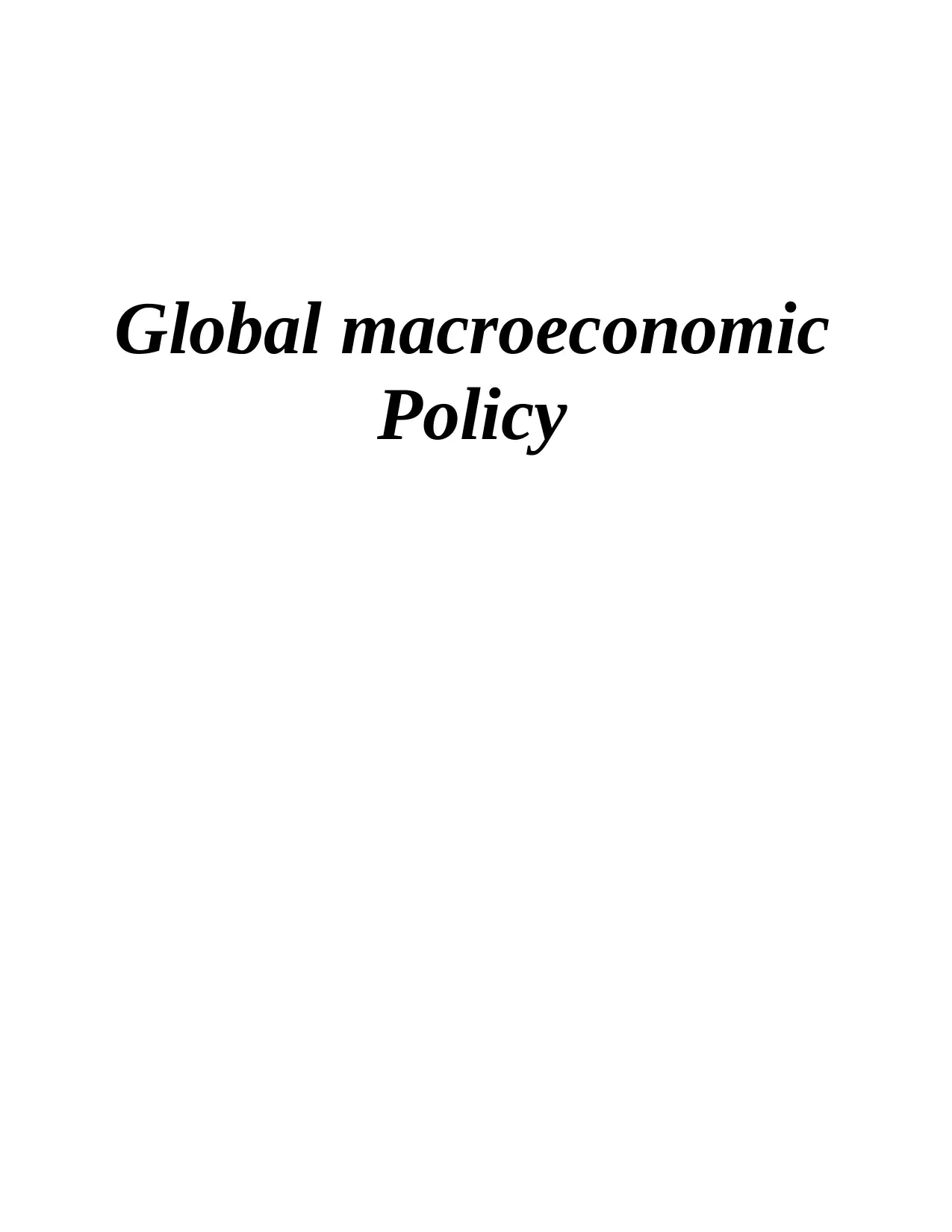
Global macroeconomic
Policy
Policy
Paraphrase This Document
Need a fresh take? Get an instant paraphrase of this document with our AI Paraphraser
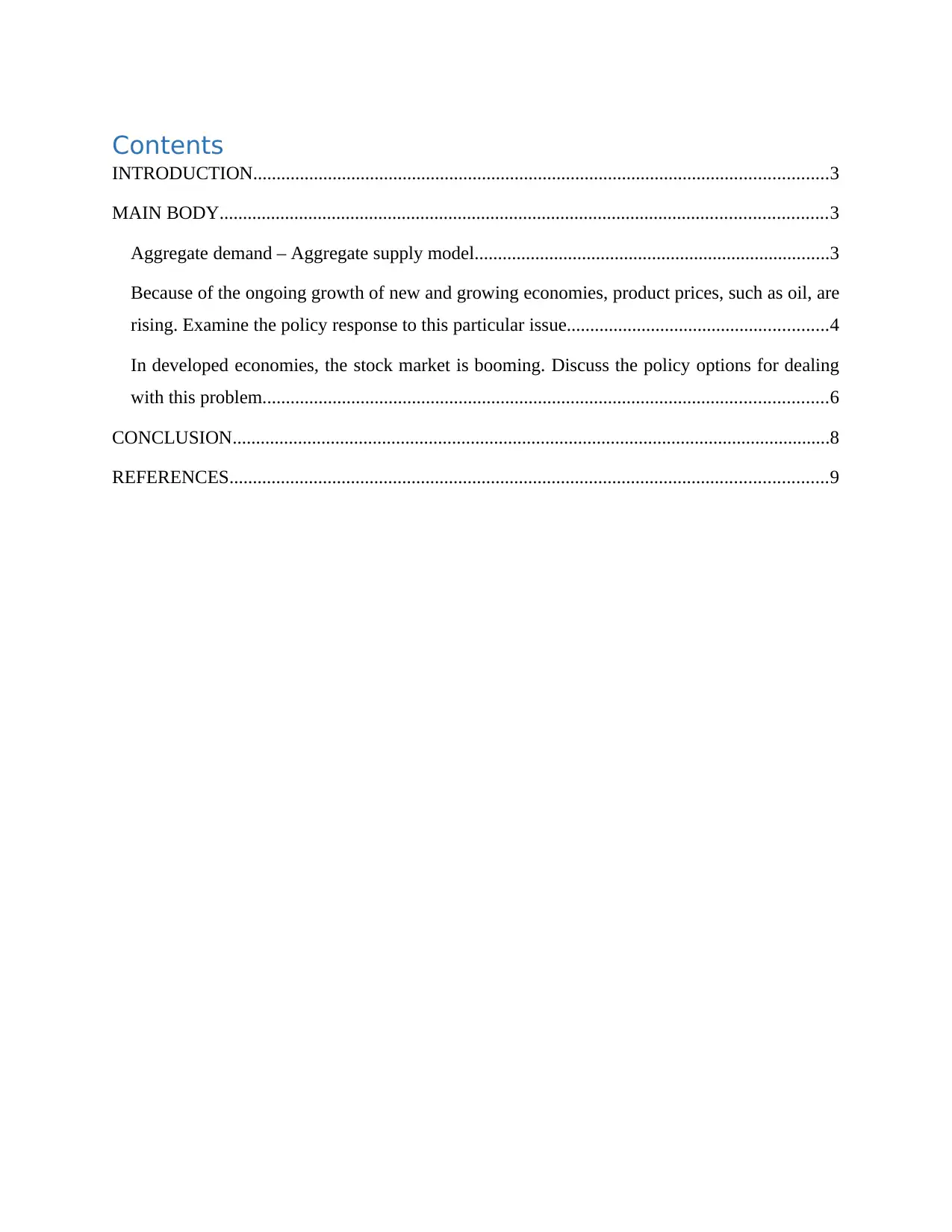
Contents
INTRODUCTION...........................................................................................................................3
MAIN BODY..................................................................................................................................3
Aggregate demand – Aggregate supply model............................................................................3
Because of the ongoing growth of new and growing economies, product prices, such as oil, are
rising. Examine the policy response to this particular issue........................................................4
In developed economies, the stock market is booming. Discuss the policy options for dealing
with this problem.........................................................................................................................6
CONCLUSION................................................................................................................................8
REFERENCES................................................................................................................................9
INTRODUCTION...........................................................................................................................3
MAIN BODY..................................................................................................................................3
Aggregate demand – Aggregate supply model............................................................................3
Because of the ongoing growth of new and growing economies, product prices, such as oil, are
rising. Examine the policy response to this particular issue........................................................4
In developed economies, the stock market is booming. Discuss the policy options for dealing
with this problem.........................................................................................................................6
CONCLUSION................................................................................................................................8
REFERENCES................................................................................................................................9

INTRODUCTION
Macroeconomics is the discipline of economics that studies the economy's overall structure,
conduct, decision-making, and performance. Short-term economic growth and long-term
economic growth are the two main forms of macroeconomics study. The country is experiencing
unequal economic development, and emerging countries must address the concerns in order to
secure long-term economic growth in the market. Price distortions, a lack of domestic resources,
and government expenditures all contribute to the economy's overall instability (Su, Khan, Tao,
and Umar, 2020). There are other factors, such as rising debt levels, financial resiliency, and the
rate of climate change, all of which are impeding the economy's total development. All of these
elements contribute to the market's equilibrium in macroeconomics. These are the variables that
assure market expansion, such as rising oil prices and a stock market boom in the advanced
economy, which are also discussed in the paper. It also covers the benefits of various policies
and their responses to policymakers who use aggregate demand and supply to operate in
macroeconomics.
MAIN BODY
Aggregate demand – Aggregate supply model
The AD-AS (aggregate demand-aggregate supply) model depicts how national income is
determined and how price levels vary. This may be used to demonstrate business cycle stages
and how different events can cause changes in two major macroeconomic indicators: real GDP
and inflation.
Macroeconomics is the discipline of economics that studies the economy's overall structure,
conduct, decision-making, and performance. Short-term economic growth and long-term
economic growth are the two main forms of macroeconomics study. The country is experiencing
unequal economic development, and emerging countries must address the concerns in order to
secure long-term economic growth in the market. Price distortions, a lack of domestic resources,
and government expenditures all contribute to the economy's overall instability (Su, Khan, Tao,
and Umar, 2020). There are other factors, such as rising debt levels, financial resiliency, and the
rate of climate change, all of which are impeding the economy's total development. All of these
elements contribute to the market's equilibrium in macroeconomics. These are the variables that
assure market expansion, such as rising oil prices and a stock market boom in the advanced
economy, which are also discussed in the paper. It also covers the benefits of various policies
and their responses to policymakers who use aggregate demand and supply to operate in
macroeconomics.
MAIN BODY
Aggregate demand – Aggregate supply model
The AD-AS (aggregate demand-aggregate supply) model depicts how national income is
determined and how price levels vary. This may be used to demonstrate business cycle stages
and how different events can cause changes in two major macroeconomic indicators: real GDP
and inflation.
⊘ This is a preview!⊘
Do you want full access?
Subscribe today to unlock all pages.

Trusted by 1+ million students worldwide
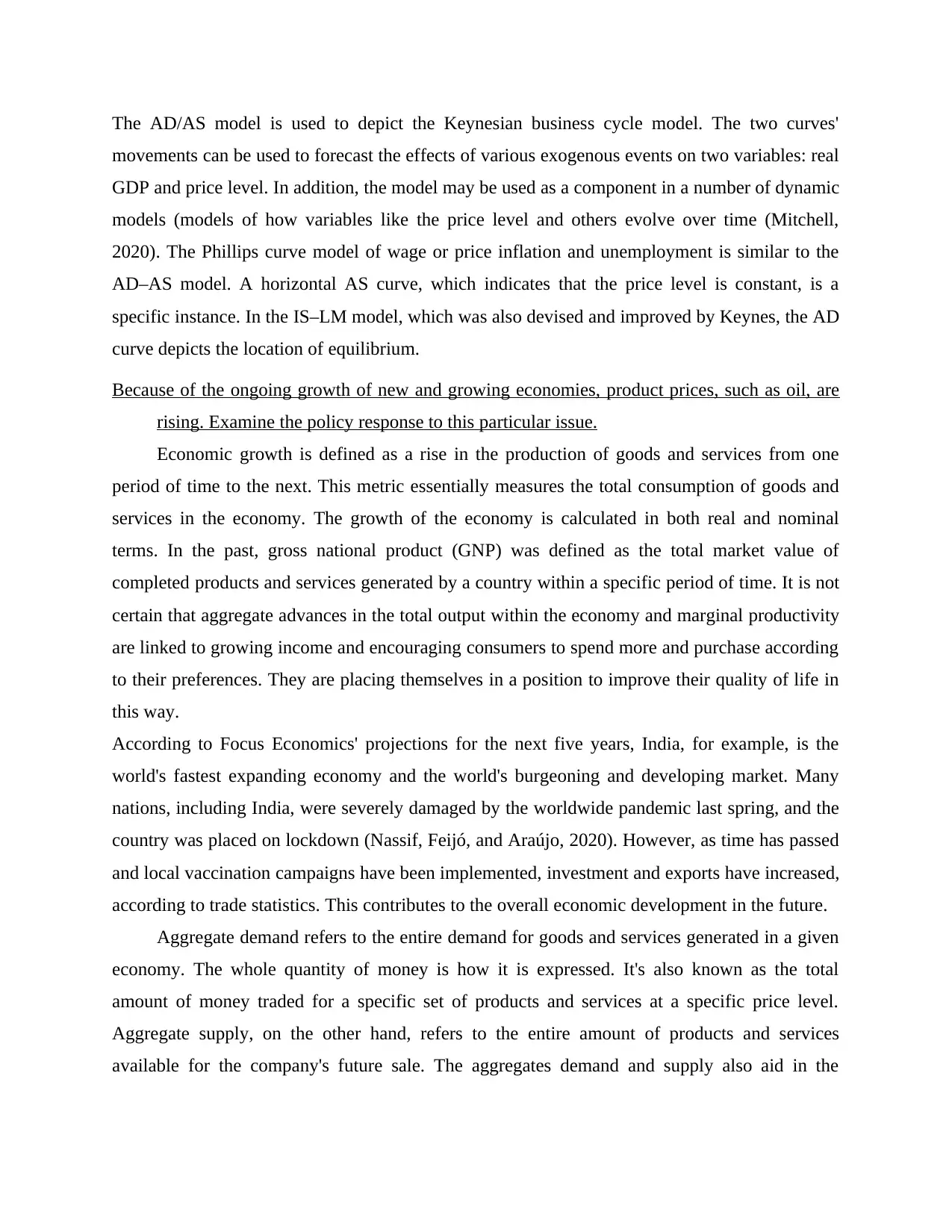
The AD/AS model is used to depict the Keynesian business cycle model. The two curves'
movements can be used to forecast the effects of various exogenous events on two variables: real
GDP and price level. In addition, the model may be used as a component in a number of dynamic
models (models of how variables like the price level and others evolve over time (Mitchell,
2020). The Phillips curve model of wage or price inflation and unemployment is similar to the
AD–AS model. A horizontal AS curve, which indicates that the price level is constant, is a
specific instance. In the IS–LM model, which was also devised and improved by Keynes, the AD
curve depicts the location of equilibrium.
Because of the ongoing growth of new and growing economies, product prices, such as oil, are
rising. Examine the policy response to this particular issue.
Economic growth is defined as a rise in the production of goods and services from one
period of time to the next. This metric essentially measures the total consumption of goods and
services in the economy. The growth of the economy is calculated in both real and nominal
terms. In the past, gross national product (GNP) was defined as the total market value of
completed products and services generated by a country within a specific period of time. It is not
certain that aggregate advances in the total output within the economy and marginal productivity
are linked to growing income and encouraging consumers to spend more and purchase according
to their preferences. They are placing themselves in a position to improve their quality of life in
this way.
According to Focus Economics' projections for the next five years, India, for example, is the
world's fastest expanding economy and the world's burgeoning and developing market. Many
nations, including India, were severely damaged by the worldwide pandemic last spring, and the
country was placed on lockdown (Nassif, Feijó, and Araújo, 2020). However, as time has passed
and local vaccination campaigns have been implemented, investment and exports have increased,
according to trade statistics. This contributes to the overall economic development in the future.
Aggregate demand refers to the entire demand for goods and services generated in a given
economy. The whole quantity of money is how it is expressed. It's also known as the total
amount of money traded for a specific set of products and services at a specific price level.
Aggregate supply, on the other hand, refers to the entire amount of products and services
available for the company's future sale. The aggregates demand and supply also aid in the
movements can be used to forecast the effects of various exogenous events on two variables: real
GDP and price level. In addition, the model may be used as a component in a number of dynamic
models (models of how variables like the price level and others evolve over time (Mitchell,
2020). The Phillips curve model of wage or price inflation and unemployment is similar to the
AD–AS model. A horizontal AS curve, which indicates that the price level is constant, is a
specific instance. In the IS–LM model, which was also devised and improved by Keynes, the AD
curve depicts the location of equilibrium.
Because of the ongoing growth of new and growing economies, product prices, such as oil, are
rising. Examine the policy response to this particular issue.
Economic growth is defined as a rise in the production of goods and services from one
period of time to the next. This metric essentially measures the total consumption of goods and
services in the economy. The growth of the economy is calculated in both real and nominal
terms. In the past, gross national product (GNP) was defined as the total market value of
completed products and services generated by a country within a specific period of time. It is not
certain that aggregate advances in the total output within the economy and marginal productivity
are linked to growing income and encouraging consumers to spend more and purchase according
to their preferences. They are placing themselves in a position to improve their quality of life in
this way.
According to Focus Economics' projections for the next five years, India, for example, is the
world's fastest expanding economy and the world's burgeoning and developing market. Many
nations, including India, were severely damaged by the worldwide pandemic last spring, and the
country was placed on lockdown (Nassif, Feijó, and Araújo, 2020). However, as time has passed
and local vaccination campaigns have been implemented, investment and exports have increased,
according to trade statistics. This contributes to the overall economic development in the future.
Aggregate demand refers to the entire demand for goods and services generated in a given
economy. The whole quantity of money is how it is expressed. It's also known as the total
amount of money traded for a specific set of products and services at a specific price level.
Aggregate supply, on the other hand, refers to the entire amount of products and services
available for the company's future sale. The aggregates demand and supply also aid in the
Paraphrase This Document
Need a fresh take? Get an instant paraphrase of this document with our AI Paraphraser
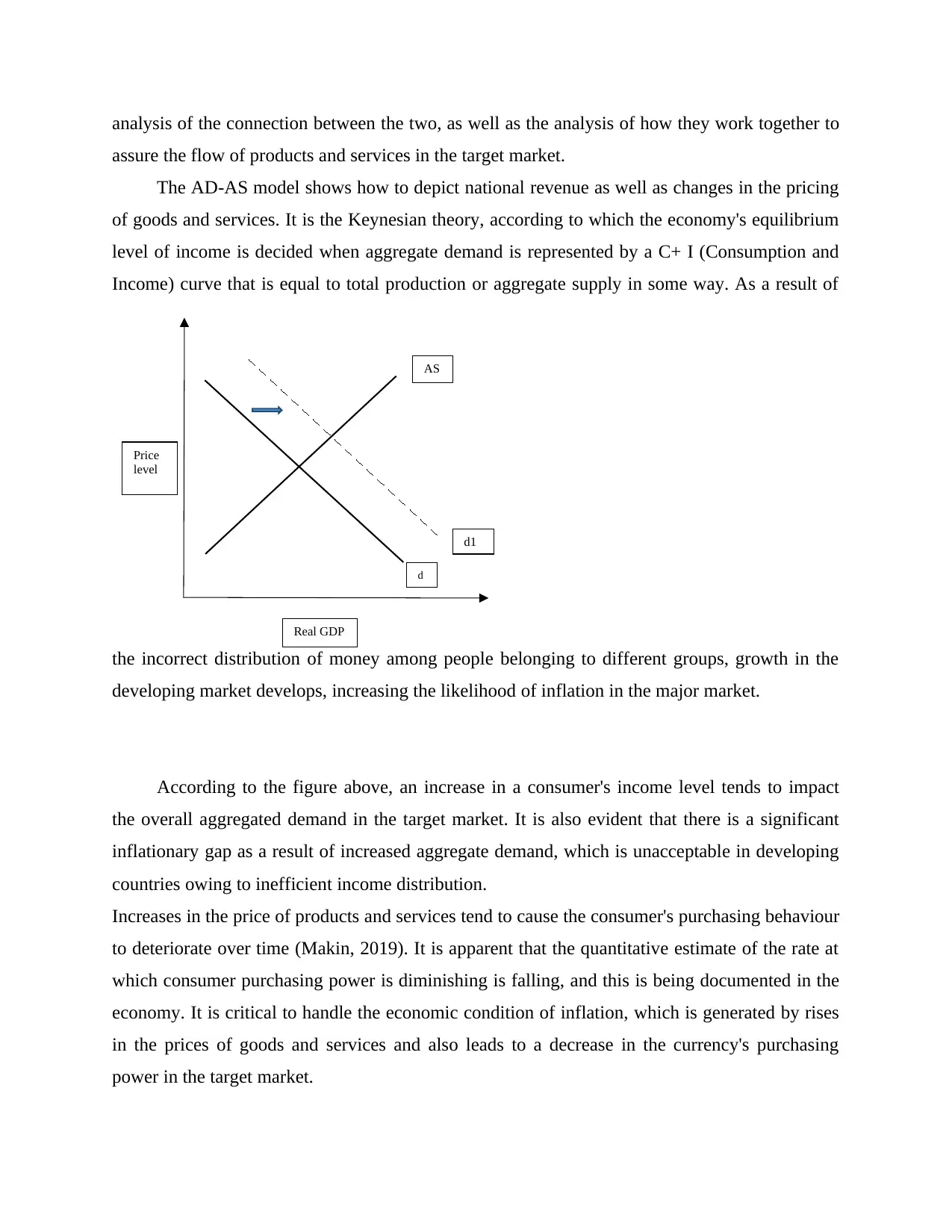
d
d1
AS
Price
level
Real GDP
analysis of the connection between the two, as well as the analysis of how they work together to
assure the flow of products and services in the target market.
The AD-AS model shows how to depict national revenue as well as changes in the pricing
of goods and services. It is the Keynesian theory, according to which the economy's equilibrium
level of income is decided when aggregate demand is represented by a C+ I (Consumption and
Income) curve that is equal to total production or aggregate supply in some way. As a result of
the incorrect distribution of money among people belonging to different groups, growth in the
developing market develops, increasing the likelihood of inflation in the major market.
According to the figure above, an increase in a consumer's income level tends to impact
the overall aggregated demand in the target market. It is also evident that there is a significant
inflationary gap as a result of increased aggregate demand, which is unacceptable in developing
countries owing to inefficient income distribution.
Increases in the price of products and services tend to cause the consumer's purchasing behaviour
to deteriorate over time (Makin, 2019). It is apparent that the quantitative estimate of the rate at
which consumer purchasing power is diminishing is falling, and this is being documented in the
economy. It is critical to handle the economic condition of inflation, which is generated by rises
in the prices of goods and services and also leads to a decrease in the currency's purchasing
power in the target market.
d1
AS
Price
level
Real GDP
analysis of the connection between the two, as well as the analysis of how they work together to
assure the flow of products and services in the target market.
The AD-AS model shows how to depict national revenue as well as changes in the pricing
of goods and services. It is the Keynesian theory, according to which the economy's equilibrium
level of income is decided when aggregate demand is represented by a C+ I (Consumption and
Income) curve that is equal to total production or aggregate supply in some way. As a result of
the incorrect distribution of money among people belonging to different groups, growth in the
developing market develops, increasing the likelihood of inflation in the major market.
According to the figure above, an increase in a consumer's income level tends to impact
the overall aggregated demand in the target market. It is also evident that there is a significant
inflationary gap as a result of increased aggregate demand, which is unacceptable in developing
countries owing to inefficient income distribution.
Increases in the price of products and services tend to cause the consumer's purchasing behaviour
to deteriorate over time (Makin, 2019). It is apparent that the quantitative estimate of the rate at
which consumer purchasing power is diminishing is falling, and this is being documented in the
economy. It is critical to handle the economic condition of inflation, which is generated by rises
in the prices of goods and services and also leads to a decrease in the currency's purchasing
power in the target market.
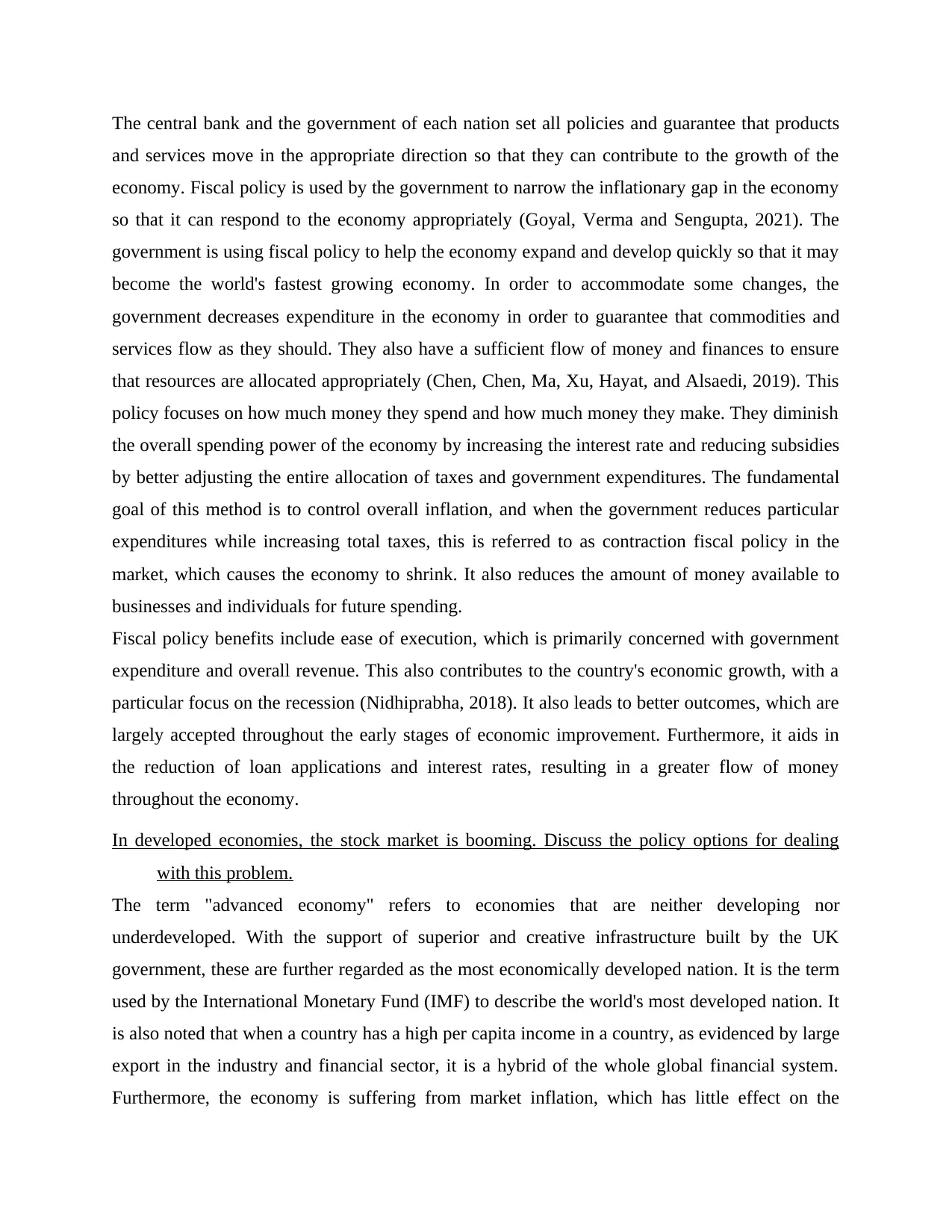
The central bank and the government of each nation set all policies and guarantee that products
and services move in the appropriate direction so that they can contribute to the growth of the
economy. Fiscal policy is used by the government to narrow the inflationary gap in the economy
so that it can respond to the economy appropriately (Goyal, Verma and Sengupta, 2021). The
government is using fiscal policy to help the economy expand and develop quickly so that it may
become the world's fastest growing economy. In order to accommodate some changes, the
government decreases expenditure in the economy in order to guarantee that commodities and
services flow as they should. They also have a sufficient flow of money and finances to ensure
that resources are allocated appropriately (Chen, Chen, Ma, Xu, Hayat, and Alsaedi, 2019). This
policy focuses on how much money they spend and how much money they make. They diminish
the overall spending power of the economy by increasing the interest rate and reducing subsidies
by better adjusting the entire allocation of taxes and government expenditures. The fundamental
goal of this method is to control overall inflation, and when the government reduces particular
expenditures while increasing total taxes, this is referred to as contraction fiscal policy in the
market, which causes the economy to shrink. It also reduces the amount of money available to
businesses and individuals for future spending.
Fiscal policy benefits include ease of execution, which is primarily concerned with government
expenditure and overall revenue. This also contributes to the country's economic growth, with a
particular focus on the recession (Nidhiprabha, 2018). It also leads to better outcomes, which are
largely accepted throughout the early stages of economic improvement. Furthermore, it aids in
the reduction of loan applications and interest rates, resulting in a greater flow of money
throughout the economy.
In developed economies, the stock market is booming. Discuss the policy options for dealing
with this problem.
The term "advanced economy" refers to economies that are neither developing nor
underdeveloped. With the support of superior and creative infrastructure built by the UK
government, these are further regarded as the most economically developed nation. It is the term
used by the International Monetary Fund (IMF) to describe the world's most developed nation. It
is also noted that when a country has a high per capita income in a country, as evidenced by large
export in the industry and financial sector, it is a hybrid of the whole global financial system.
Furthermore, the economy is suffering from market inflation, which has little effect on the
and services move in the appropriate direction so that they can contribute to the growth of the
economy. Fiscal policy is used by the government to narrow the inflationary gap in the economy
so that it can respond to the economy appropriately (Goyal, Verma and Sengupta, 2021). The
government is using fiscal policy to help the economy expand and develop quickly so that it may
become the world's fastest growing economy. In order to accommodate some changes, the
government decreases expenditure in the economy in order to guarantee that commodities and
services flow as they should. They also have a sufficient flow of money and finances to ensure
that resources are allocated appropriately (Chen, Chen, Ma, Xu, Hayat, and Alsaedi, 2019). This
policy focuses on how much money they spend and how much money they make. They diminish
the overall spending power of the economy by increasing the interest rate and reducing subsidies
by better adjusting the entire allocation of taxes and government expenditures. The fundamental
goal of this method is to control overall inflation, and when the government reduces particular
expenditures while increasing total taxes, this is referred to as contraction fiscal policy in the
market, which causes the economy to shrink. It also reduces the amount of money available to
businesses and individuals for future spending.
Fiscal policy benefits include ease of execution, which is primarily concerned with government
expenditure and overall revenue. This also contributes to the country's economic growth, with a
particular focus on the recession (Nidhiprabha, 2018). It also leads to better outcomes, which are
largely accepted throughout the early stages of economic improvement. Furthermore, it aids in
the reduction of loan applications and interest rates, resulting in a greater flow of money
throughout the economy.
In developed economies, the stock market is booming. Discuss the policy options for dealing
with this problem.
The term "advanced economy" refers to economies that are neither developing nor
underdeveloped. With the support of superior and creative infrastructure built by the UK
government, these are further regarded as the most economically developed nation. It is the term
used by the International Monetary Fund (IMF) to describe the world's most developed nation. It
is also noted that when a country has a high per capita income in a country, as evidenced by large
export in the industry and financial sector, it is a hybrid of the whole global financial system.
Furthermore, the economy is suffering from market inflation, which has little effect on the
⊘ This is a preview!⊘
Do you want full access?
Subscribe today to unlock all pages.

Trusted by 1+ million students worldwide
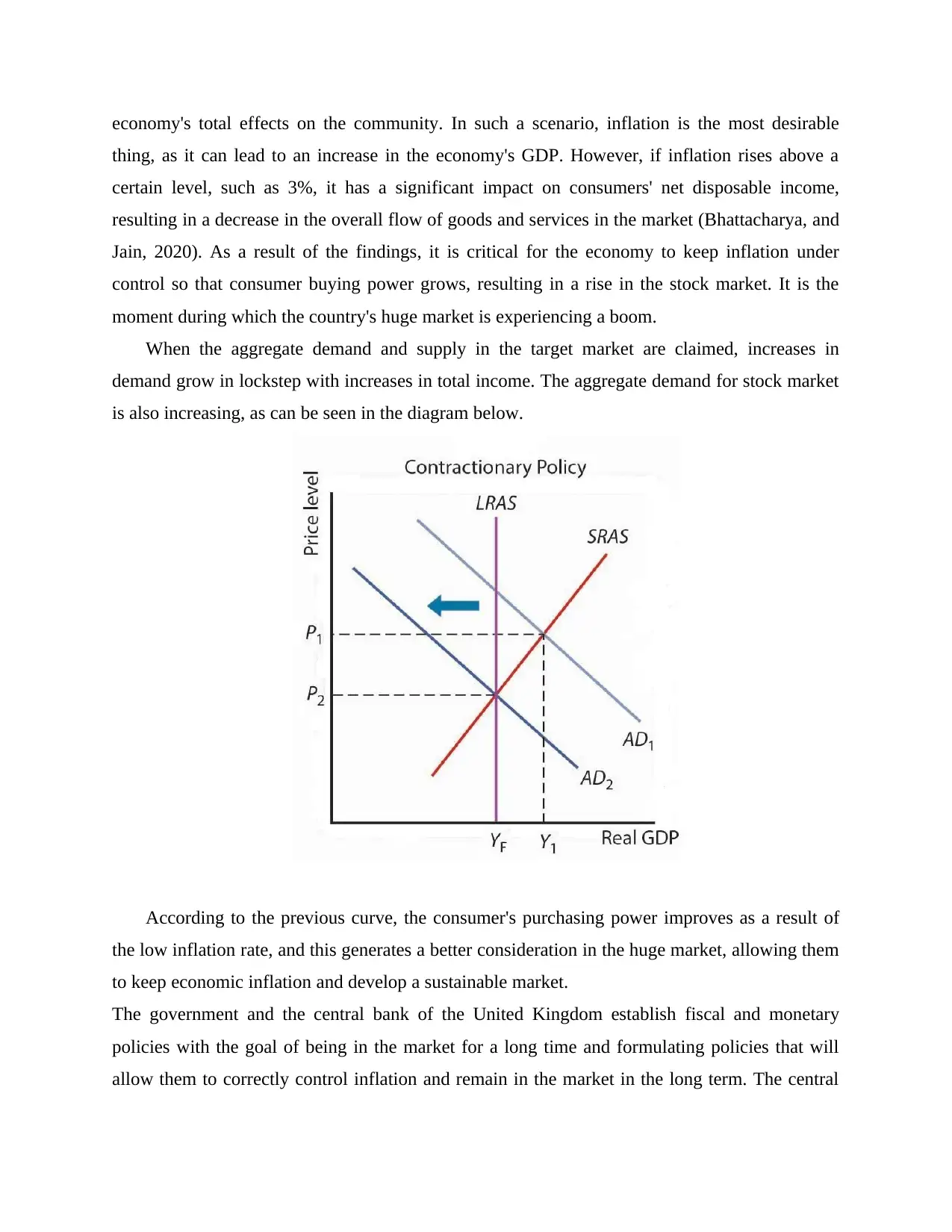
economy's total effects on the community. In such a scenario, inflation is the most desirable
thing, as it can lead to an increase in the economy's GDP. However, if inflation rises above a
certain level, such as 3%, it has a significant impact on consumers' net disposable income,
resulting in a decrease in the overall flow of goods and services in the market (Bhattacharya, and
Jain, 2020). As a result of the findings, it is critical for the economy to keep inflation under
control so that consumer buying power grows, resulting in a rise in the stock market. It is the
moment during which the country's huge market is experiencing a boom.
When the aggregate demand and supply in the target market are claimed, increases in
demand grow in lockstep with increases in total income. The aggregate demand for stock market
is also increasing, as can be seen in the diagram below.
According to the previous curve, the consumer's purchasing power improves as a result of
the low inflation rate, and this generates a better consideration in the huge market, allowing them
to keep economic inflation and develop a sustainable market.
The government and the central bank of the United Kingdom establish fiscal and monetary
policies with the goal of being in the market for a long time and formulating policies that will
allow them to correctly control inflation and remain in the market in the long term. The central
thing, as it can lead to an increase in the economy's GDP. However, if inflation rises above a
certain level, such as 3%, it has a significant impact on consumers' net disposable income,
resulting in a decrease in the overall flow of goods and services in the market (Bhattacharya, and
Jain, 2020). As a result of the findings, it is critical for the economy to keep inflation under
control so that consumer buying power grows, resulting in a rise in the stock market. It is the
moment during which the country's huge market is experiencing a boom.
When the aggregate demand and supply in the target market are claimed, increases in
demand grow in lockstep with increases in total income. The aggregate demand for stock market
is also increasing, as can be seen in the diagram below.
According to the previous curve, the consumer's purchasing power improves as a result of
the low inflation rate, and this generates a better consideration in the huge market, allowing them
to keep economic inflation and develop a sustainable market.
The government and the central bank of the United Kingdom establish fiscal and monetary
policies with the goal of being in the market for a long time and formulating policies that will
allow them to correctly control inflation and remain in the market in the long term. The central
Paraphrase This Document
Need a fresh take? Get an instant paraphrase of this document with our AI Paraphraser

bank of the United Kingdom uses monetary policy to keep the inflationary gap open, allowing
them to handle the economy's general state. The discount rate, open market operations, and
reserve requirements are all examples of monetary policy instruments. This monetary policy aids
in the regulation of money supply, and citizens of the country handle money in an acceptable
manner so that it is dispersed throughout the economy. Because the government assists the
market bank in controlling inflation in the economy (Lipschitz, and Schadler, 2019). As a result
of the National Bank of England's aid to banks, the overall consumption rate in the UK economy
has decreased. The bank raises its borrowing rate, causing purchasers to pay higher interest rates
and reducing the total amount of money in circulation in the vast market. People have a
propensity to impact the overall supply of money in the economy as a result of the outcomes.
Monetary policy aids in luring consumer spending, resulting in an expansionary monetary policy
in which banks offer low interest rates on mortgages and loans in order to encourage businesses
to flourish, resulting in the economy's effective working conditions (Brancaccio, and Califano,
2022). The feature of contractionary monetary policy tries to limit the amount of money
accessible in the country. The fundamental goal of this strategy is to keep inflation at a
manageable level. When there is inflation in the market, it leads to a higher rate of borrowing
from the bank, allowing the bank to reduce the overall amount of money in the economy.
CONCLUSION
The above report concludes that macroeconomics is the study of the behaviour of the
regional and national economies as a whole. It is primarily concerned with the overall amount of
goods and services generated in the economy. The development of the developing economy has
had an impact on the whole economy, and when the total interest rate and aggregate demand are
considered, they will move in the market in a general way, as they tend to pay the overall
economy in the market. The financial components help to establish the supplier and also show
that the entire cash flow is the most important factor to consider while looking for a job.
them to handle the economy's general state. The discount rate, open market operations, and
reserve requirements are all examples of monetary policy instruments. This monetary policy aids
in the regulation of money supply, and citizens of the country handle money in an acceptable
manner so that it is dispersed throughout the economy. Because the government assists the
market bank in controlling inflation in the economy (Lipschitz, and Schadler, 2019). As a result
of the National Bank of England's aid to banks, the overall consumption rate in the UK economy
has decreased. The bank raises its borrowing rate, causing purchasers to pay higher interest rates
and reducing the total amount of money in circulation in the vast market. People have a
propensity to impact the overall supply of money in the economy as a result of the outcomes.
Monetary policy aids in luring consumer spending, resulting in an expansionary monetary policy
in which banks offer low interest rates on mortgages and loans in order to encourage businesses
to flourish, resulting in the economy's effective working conditions (Brancaccio, and Califano,
2022). The feature of contractionary monetary policy tries to limit the amount of money
accessible in the country. The fundamental goal of this strategy is to keep inflation at a
manageable level. When there is inflation in the market, it leads to a higher rate of borrowing
from the bank, allowing the bank to reduce the overall amount of money in the economy.
CONCLUSION
The above report concludes that macroeconomics is the study of the behaviour of the
regional and national economies as a whole. It is primarily concerned with the overall amount of
goods and services generated in the economy. The development of the developing economy has
had an impact on the whole economy, and when the total interest rate and aggregate demand are
considered, they will move in the market in a general way, as they tend to pay the overall
economy in the market. The financial components help to establish the supplier and also show
that the entire cash flow is the most important factor to consider while looking for a job.
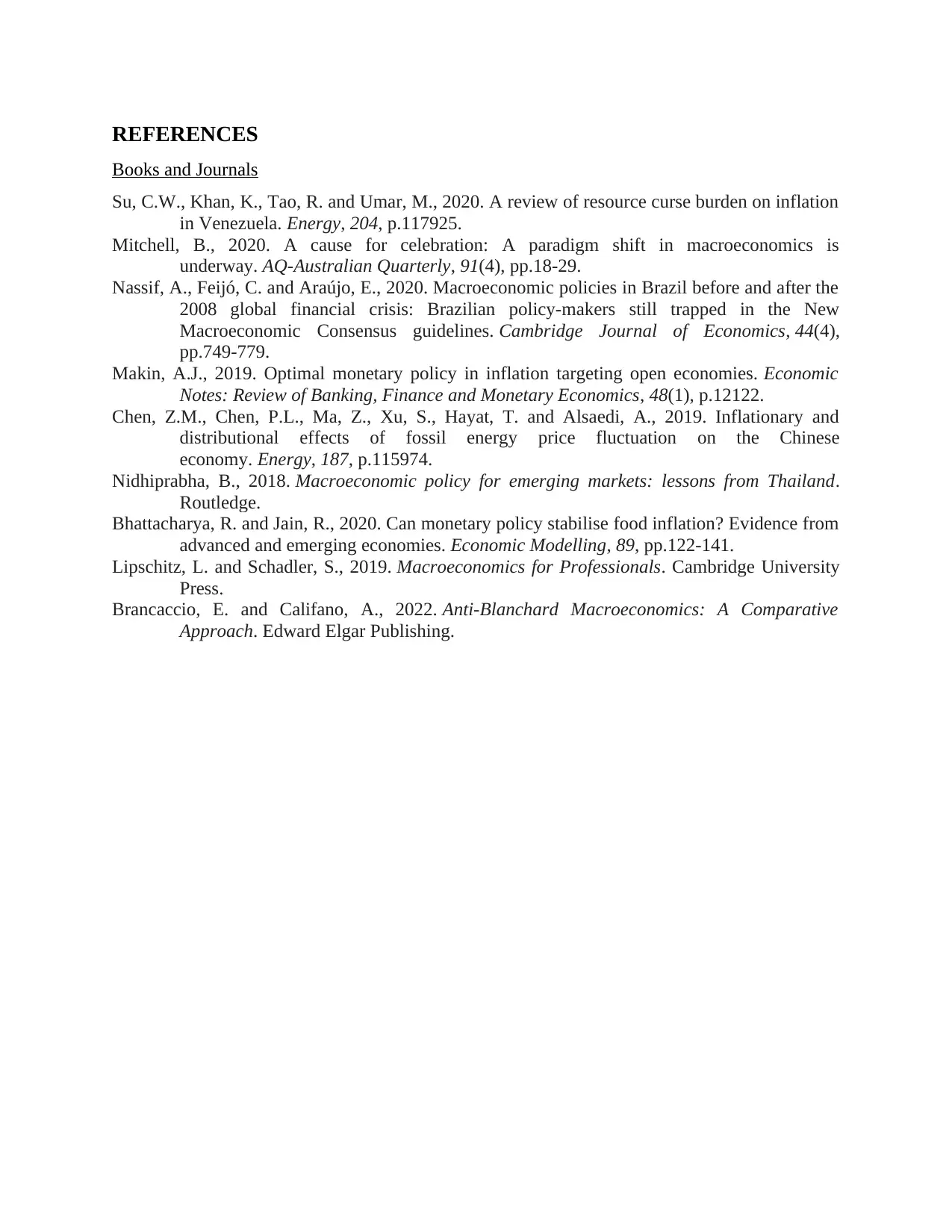
REFERENCES
Books and Journals
Su, C.W., Khan, K., Tao, R. and Umar, M., 2020. A review of resource curse burden on inflation
in Venezuela. Energy, 204, p.117925.
Mitchell, B., 2020. A cause for celebration: A paradigm shift in macroeconomics is
underway. AQ-Australian Quarterly, 91(4), pp.18-29.
Nassif, A., Feijó, C. and Araújo, E., 2020. Macroeconomic policies in Brazil before and after the
2008 global financial crisis: Brazilian policy-makers still trapped in the New
Macroeconomic Consensus guidelines. Cambridge Journal of Economics, 44(4),
pp.749-779.
Makin, A.J., 2019. Optimal monetary policy in inflation targeting open economies. Economic
Notes: Review of Banking, Finance and Monetary Economics, 48(1), p.12122.
Chen, Z.M., Chen, P.L., Ma, Z., Xu, S., Hayat, T. and Alsaedi, A., 2019. Inflationary and
distributional effects of fossil energy price fluctuation on the Chinese
economy. Energy, 187, p.115974.
Nidhiprabha, B., 2018. Macroeconomic policy for emerging markets: lessons from Thailand.
Routledge.
Bhattacharya, R. and Jain, R., 2020. Can monetary policy stabilise food inflation? Evidence from
advanced and emerging economies. Economic Modelling, 89, pp.122-141.
Lipschitz, L. and Schadler, S., 2019. Macroeconomics for Professionals. Cambridge University
Press.
Brancaccio, E. and Califano, A., 2022. Anti-Blanchard Macroeconomics: A Comparative
Approach. Edward Elgar Publishing.
Books and Journals
Su, C.W., Khan, K., Tao, R. and Umar, M., 2020. A review of resource curse burden on inflation
in Venezuela. Energy, 204, p.117925.
Mitchell, B., 2020. A cause for celebration: A paradigm shift in macroeconomics is
underway. AQ-Australian Quarterly, 91(4), pp.18-29.
Nassif, A., Feijó, C. and Araújo, E., 2020. Macroeconomic policies in Brazil before and after the
2008 global financial crisis: Brazilian policy-makers still trapped in the New
Macroeconomic Consensus guidelines. Cambridge Journal of Economics, 44(4),
pp.749-779.
Makin, A.J., 2019. Optimal monetary policy in inflation targeting open economies. Economic
Notes: Review of Banking, Finance and Monetary Economics, 48(1), p.12122.
Chen, Z.M., Chen, P.L., Ma, Z., Xu, S., Hayat, T. and Alsaedi, A., 2019. Inflationary and
distributional effects of fossil energy price fluctuation on the Chinese
economy. Energy, 187, p.115974.
Nidhiprabha, B., 2018. Macroeconomic policy for emerging markets: lessons from Thailand.
Routledge.
Bhattacharya, R. and Jain, R., 2020. Can monetary policy stabilise food inflation? Evidence from
advanced and emerging economies. Economic Modelling, 89, pp.122-141.
Lipschitz, L. and Schadler, S., 2019. Macroeconomics for Professionals. Cambridge University
Press.
Brancaccio, E. and Califano, A., 2022. Anti-Blanchard Macroeconomics: A Comparative
Approach. Edward Elgar Publishing.
⊘ This is a preview!⊘
Do you want full access?
Subscribe today to unlock all pages.

Trusted by 1+ million students worldwide
1 out of 9
Related Documents
Your All-in-One AI-Powered Toolkit for Academic Success.
+13062052269
info@desklib.com
Available 24*7 on WhatsApp / Email
![[object Object]](/_next/static/media/star-bottom.7253800d.svg)
Unlock your academic potential
Copyright © 2020–2025 A2Z Services. All Rights Reserved. Developed and managed by ZUCOL.




